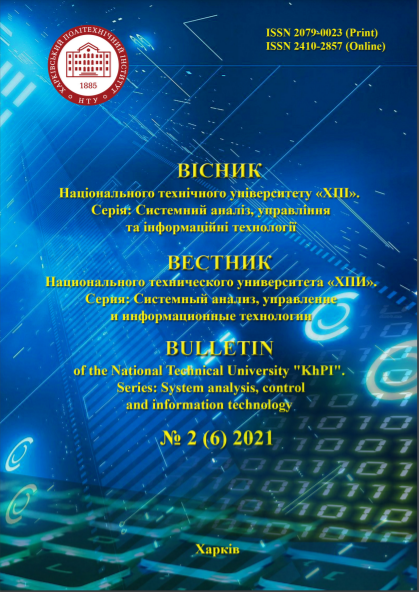MATHEMATICAL MODEL OF ADAPTIVE CONTROL OF THE FUNCTIONING OF A TRAFFIC LIGHT AT THE CROSSROADS OF A URBAN TRANSPORTATION NETWORK
DOI:
https://doi.org/10.20998/2079-0023.2021.02.09Keywords:
mathematical model, traffic light, adaptive control, crossroads, microcontroller, softwareAbstract
The subject of the research is the process of modeling the functioning of a traffic light, providing adaptive control of vehicles at the intersections
of the city transport network. In the process of functioning of urban transport networks, such phenomena as traffic jams occur, which lead to
significant economic losses, environmental degradation, frustration of road users and other types of negative impacts. Traffic jams often occur at the
nodes of the urban transport network, which are intersections - the places of intersection, abutment or branching of roads of the urban network of the
same level. One of the causes of congestion is the ineffective management of traffic flows at intersections, which is provided by such an element of the
intersection as a traffic light. Within the framework of the existing transport network, traffic lights that implement adaptive control with the help of
appropriate local controllers, and more complex system controllers created on their basis, ensuring that the situation in the external environment is
taken into account, which is represented by several interconnected intersections, is currently one of the most important directions for solving the
problem of traffic jams. The traffic light flow control function is implemented using a microprocessor controller, which, according to a given algorithm, switches the traffic light colors corresponding to the phases of allowing and prohibiting the movement of the vehicle in the directions of the
intersection roads.
The article proposes a mathematical model for building an algorithm for the functioning of a microprocessor traffic light controller, which
provides a prompt and adequate display of situations at intersections. The main features of the model include responsiveness to changes in situations at
an intersection by changing the duration of the permissive phase of movement in each cycle of traffic light operation in proportion to the length of the
queue of vehicles in the corresponding direction of travel; adequate display of the external environment by several expressions of Poisson’s law,
differing in different values of the parameter, each of which corresponds to a certain daily interval of traffic light functioning; the dynamics of changes
in the traffic situation due to a decrease in the number of vehicles in the queue due to the passage of the intersection by vehicles during the green phase
of the traffic light is determined on the basis of expressions that determine the movement of bodies with uniformly accelerated and uniform movement,
as well as on the basis of the differential equation of the dynamics of movement of vehicles in one row taking into account the delay caused by the
reaction of drivers.
References
Adaptivnoe upravlenie svetofornimi obektami [Adaptive traffic light control]. URL: https://spetsdor.ru/cases/adaptivnoe-upravleniesvetofornymi-obektami/ (accessed 28.10.2021).
Adaptivnaya sistema upravleniya svetoforami teper' rabotaet na 10 perekrestkah Kemerovo [The adaptive traffic light control system now works at 10 intersections in Kemerovo]. URL: https://news.drom.ru/30855.html (accessed 17.10.2021).
Abramov M. K., Prokopov A. G. Specialnaya tehnika v OVD: uchebno-metodicheskie rekomendacii [Special equipment in the police department: educational and methodological recommendations]. Belgorod, Bel YUI MVD Rossii Publ., 2015. 176 p.
svetofora v Sankt‑Peterburge budut osnashcheny adaptivnymi rezhimami upravleniya [163 traffic lights in St. Petersburg will be equipped with adaptive control modes]. URL: https://www.gov.spb.ru/gov/otrasl/tr_infr_kom/news/59538/ (accessed 28.10.2021).
Mirzai H. Razrabotka adaptivnogo algoritma kontrolera svetofora s prioritetnoi viborkoi v rezhime realnogo vremeni [Development of an adaptive algorithm for a traffic light controller with priority sampling in real time]. Vestnik VGU, seriya: sistemnii analiz i informacionnie tehnologii [Voronezh State University Bulletin, series: system analysis and information technology]. Voronezh, 2016, no. 1, pp. 26–32.
Algoritmy adaptivnogo regulirovaniya svetofornoj signalizacii [Algorithms for adaptive control of traffic light signaling]. URL: http://surl.li/aysmg (accessed 12.10.2021).
Raspredelenie i formula Puassona [Distribution and Poisson's formula]. URL: http://mathprofi.ru/raspredelenie_i_formula_puassona.html (accessed 28.10.2021).
Bilyalov R. F. Teoriya veroyatnostei i matematicheskaya statistika. Lekcionnii kurs i prakticheskie zanyatiya [Probability theory and mathematical statistics. Lecture course and practical exercises]. Kazan, Kazanskii gosudarstvennii universitet Publ., 2004. 138 p.
Gevorkyan E. A. Differencial'nye uravneniya s zapazdyvayushchim argumentom: uchebno-metodicheskij kompleks [Differential equations with lagging argument: educational-methodical complex]. Moscow, Evrazijskij otkrytyj institut Publ., 2011. 155 p.
Bordovskii G. A., Kondratev A. S., Chouderi A. Fizicheskie osnovi matematicheskogo modelirovaniya. Uchebnik i praktikum dlya bakalavriata i magistraturi [Physical foundations of mathematical modeling. Textbook and workshop for undergraduate and graduate programs]. Moscow, Yurait Publ., 2017. 320 p.
Peremeshchenie tela pri pryamolinejnom ravnouskorennom dvizhenii bez nachal'noj skorosti [Moving a body in a rectilinear uniformly accelerated motion without an initial speed]. URL: https://100ballov.kz/mod/page/view.php?id=2576 (accessed 28.10.2021).
Rivnopriskorenii ruh [Uniformly accelerated motion]. URL: https://goo.su/9Qv8 (accessed 17.10.2021).
Downloads
Published
How to Cite
Issue
Section
License
LicenseAuthors who publish with this journal agree to the following terms:
- Authors retain copyright and grant the journal right of first publication with the work simultaneously licensed under a Creative Commons Attribution License that allows others to share the work with an acknowledgement of the work's authorship and initial publication in this journal.
- Authors are able to enter into separate, additional contractual arrangements for the non-exclusive distribution of the journal's published version of the work (e.g., post it to an institutional repository or publish it in a book), with an acknowledgement of its initial publication in this journal.
- Authors are permitted and encouraged to post their work online (e.g., in institutional repositories or on their website) prior to and during the submission process, as it can lead to productive exchanges, as well as earlier and greater citation of published work (See The Effect of Open Access).


